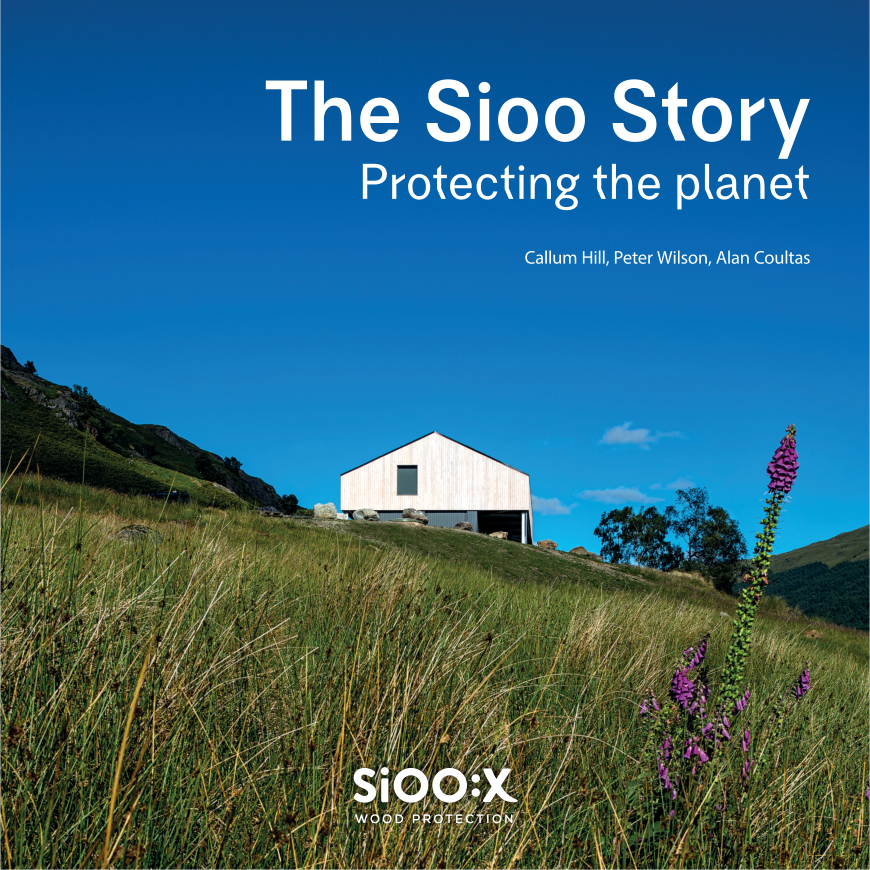The SiOO:X Story
Protecting the Planet
The SiOO:X Story
Sioo Wood Protection wants to help create good architecture in high quality wood.
So we are highly focused on creating a wood protector that gives architects creative freedom in the creation process, enabling them to achieve their architectonic vision. This applies regardless of whether the project is the world’s tallest wooden skyscraper or smaller wooden buildings being constructed cost-effectively in parts of the world where economic conditions are tough.
Read our book here
The Sioo Story – Protecting the planet
Click on the image of the book, you will leave the website and open an integrated app.
Good reading
Acknowledgements
IN HIS BOOK “Wood Modification”, Callum Hill refers to the enormous potential in the new industry that has emerged from the development of wood modification technologies. One such technology is impregnation modification using silicates. This is the story of one company, Sioo Wood Protection AB, told through the development of its silicate wood protec-tion technology and the application of the resulting products to a range of interesting wooden building projects.
OUR BOOK WAS started just before the onset of the COVID pandemic. This has taken its toll in time, resource and people impact and it became apparent that to bring the work to fruition required a team approach and could not be a solitary exercise. Hence the joint authorship. In this regard, particular acknowledgments are made to Peter Wilson who battled to make progress in increasingly difficult circumstances.
THIS BOOK WOULD not have been possible without the generous contri-bution of three particular professional groups: the architectural practices whose inspirational work is presented in these pages; the photographers whose outstanding images have captured the essence of the featured projects and the manufacturing specialists who delivered such high qu-ality work.
THANKS ARE DUE to all of the Sioo team and especially to the Sioo foun-der, Herje Bostrom, whose story in essence this is. He has been commit-ted, encouraging and patient as the authors have worked through times like no other.
THIS BOOK IS dedicated to all of the families of those who have contri-buted to it in any way and to those working to develope and apply tech-nologies to save the planet.
Alan Coultas, 2021
Foreword
IT GIVES ME great pleasure to have been given the oppor tunity for writing the Foreword for this book. The use of timber in construction is undergoing a renaissance, with the increasing use of laminated timber products and offsite modular timber buildings. The recent report for the UK Climate Change Com-mittee, highlighted the important role that the use of timber in construction has to play as a climate change mitigation strategy. In the housing sector, many new buildings have the structural elements made from timber, or timber-based products, but very often the external skin of the building is clad with in organic materials. This can be for many reasons, including cultural and concerns about durability. In the UK, for example, timber clad-ding is not a major part of the vernacular building culture, in marked contrast to the Scandinavian countries.
There is a growing appreciation of the benefits of using timber as a cladding material, with many excellent examples of the use in buildings, as this book amply illustrates. However, there are still a great many houses built where timber cladding is not used and some of the reasons are connected to the perceived higher maintenance requirements, or need for replacement. Some of this reticence is connected to the appearance of poorly detailed timber clad buildings, especially where there is unsightly uneven weathering. Exposed faces form a grey patina, whereas, shel-tered parts of the building remain un-weathered. This problem can be dealt with by painting the wood, or by applying stains, but many architects like the weathered silvery/grey appearance and there is an increased interest in using wood and displaying its decorative qualities in the ‘raw’ state.
The buildings shown in this book illustrate some excellent ex-amples of the use of timber as a cladding material; which has not only a functional purpose but adds immensely to the dec-orative appearance of the building. An aesthetically pleasing more natural built environment is essential to all of us for our physical and emotional well-being. Looking to the future the use of timber as a construction material has a very important role to play not only as a long-term carbon store, but also as a beautiful pleasing material that enhances our daily lives.
Ed Suttie, BRE
Please go to the book and –> read more.
